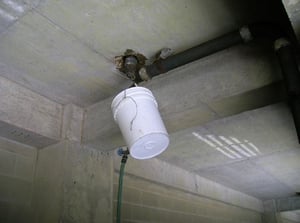I really am not sure how else to describe this photo provided by Rachel Hildebrand, except as ingenious. I can imagine the facilities maintenance staff having been called once too often to clean up the water inside the building after each rainstorm. Ingenuity is not necessarily an effective maintenance policy.
People, just like nature, follow laws of physics and thermodynamics. Objects at rest like to remain at rest and systems like to remain at equilibrium. Putting objects and people into motion and disturbing the equilibrium both require energy. Operating and maintaining building systems requires energy - not just primary energy to run the heating and cooling plant and other utilities, but energy of the occupants and maintenance staff too.
Think about the process and imagine the energy required. Each step may seem insignificant, but taken in total can equate to hours of time and plenty of expended energy.
- Occupant notices water on floor.
- Calls maintenance department to report condition
- Maintenance clerk records problem and creates work order
- Work order reviewed by maintenance supervisor for prioritization
- Maintenance clerk assigns work order to mechanic
- Mechanic investigates condition
- A ladder would be nice, so back to the shop
- Leak reported as problem with roof drain, requiring different mechanic
- New work order written and process starts over
Meanwhile another storm approaches and there is water on the floor again. Now in some industries and in some locations water on the floor may not be a big deal. But for others, where slip-and-fall law suits are prevalent, walking surfaces perceived to be unsafe are a major concern. Any law suit will put many people into motion and will escalate entropy significantly requiring exceptional energy input before returning to a state of equilibrium.
Perhaps the roofer is busy with a different problem. Perhaps the priority for roof repairs is low. Perhaps the roof is scheduled for replacement within the year. Systems are not perfect and there are always choices. So the leak continues.
Now the mechanic is called to clean the floor during every rain storm, essentially standing by to keep the floor dry. Tired of mop duty, the mechanic devises a way. Yes, people will always find a way to remain at rest.
No need for another work order. All the required supplies are available in the maintenance shop:
- Some #9 ceiling suspension wire
- A five gallon bucket
- A brass hose bib
- And a length of garden hose.
Let's hope the garden hose is directed to a nearby floor drain. And let's hope the hose bib remains open. Let's hope the wire winding will support the bucket when full of water. This solution could last indefinitely, as long as the roof drain leak continues to follow the piping and drip from the elbow.
The photo looks like a back of house space. How else would the mechanic get away with the garden hose? Well how about this rather public similar solution at an airport terminal? This caught more than one questioning glance.
We can chuckle at Rube Goldberg solutions that provide an ingenious fix using readily available materials to more complex problems. We cannot ignore the fact that buildings are designed to function in specific ways. Systems are provided and must be maintained to effectively serve a particular function throughout the life of the building. Simply masking the problem with a quick fix may do more harm than good by allowing undetected deterioration to continue until the damage become extensive and the repairs become very expensive.


